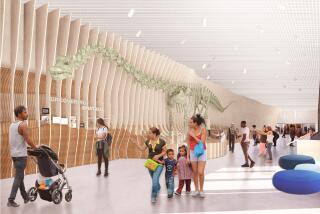Some fossils are out of time at small Bakersfield museum
For the crew from a small Bakersfield museum, the trip home from an auction house in Los Angeles was bittersweet. They had managed to retrieve some of the fossils that had been on display at the museum for years, but many others were left behind, out of reach forever.
Their two SUVs were packed with what museum supporters could acquire for the $24,000 theyâd raised: ancient whale vertebrae, a dolphin skull, teeth from an array of sharks and the four-tusked hippopotamus-like desmostylus â all collected locally. The cast of a baleen whale skull and four passengers were jammed into a Suburban that belonged to Koral Hancharick, the Buena Vista Museum of Natural Historyâs part-time director.
âIt was quite sad,â she said. âIt was wonderful to purchase as many things as we did, but it was heartbreaking to see specimens sold.â
The 15-year-old museum was started largely to house fossils unearthed by Bob Ernst, an enthusiastic amateur paleontologist. Ernst owned about 400 acres of barren ground near Bakersfield that holds a vast trove of fossils from the Miocene Epoch, a time 14 million to 16 million years ago when much of the region lay beneath an inland sea.
Sitting next to Sharktooth Hill, a national natural landmark, Ernstâs property has one of the richest deposits of marine mammal bones anywhere, said Jere Lipps, a UC Berkeley professor of integrative biology. Itâs part of a formation, known as the Round Mountain Silt, frequently likened to the Dinosaur National Monument in scientific importance.
Ernst, a former furniture salesman who became a self-taught fossil expert, died in 2007 at 70. His widow, Mary Ernst, ran into health and financial problems, Hancharick said, and decided to sell the collection that has drawn extensive interest from paleontologists and fossil buffs around the world.
âWhen the museum started it was very small â and as it grew, no formal papers were ever put together,â Hancharick said. âEveryone was friends with Bob Ernst, and he used to say the specimens would always be at the museum. Thatâs where he wanted them â in Kern County.â
Mary Ernst could not be reached for comment.
Last August, she directed Bonhams and Butterfields, an international auction house, to box up and haul off most of the fossils in the museumâs displays.
âSheâd notified us a couple of months earlier and we asked for more time,â Hancharick said. âWe were under the impression she was going to work with us.â
At auction earlier this month, some of the museumâs signature pieces â like the skeleton of an allodesmus, ancestor of the sea lion â failed to sell. It was priced at $150,000 â an impossible stretch for an institution that raised funds with countertop donation jars and restaurant nights. Another auction is set for this spring, Hancharick said, but itâs unclear whether Ernstâs items will be on the block again.
The museum is not contesting Mary Ernstâs ownership, but experts who know the collection are upset that some key pieces are destined to be kept from further scientific scrutiny.
With new discoveries in the field or lab, researchers often take another look at museum fossils, adding context and meaning to what otherwise would be isolated bits of bone.
âThe loss is horrendous,â said Robin Turner, a paleontologist and archeologist who is on the museumâs board of scientific advisors.
Ending scientistsâ access to important paleontological finds is âthe equivalent of reading a book with one of every 10 pages missing,â Turner said. âYou know something is there, but you donât know what it is.â
Private collectors, particularly from overseas, have paid big money for fossils and Ernst himself used to sell shark teeth to help keep the museum afloat. Fossils have been integrated into fancy kitchen sinks and counters.
âA lot of the smaller specimens would actually work with peopleâs décor,â noted a website previewing the Bonhams auction.
At Buena Vista Museum, the décor these days is a little starker. The ancient bones took up only about 10% of the museumâs floor space, but they were the big draw, Hancharick said.
âIt was devastating to see the empty cases,â she said, âbut now itâs time to rebuild.â
Attempts to raise funds are ongoing, as is the inadvertent lesson of Bob Ernstâs death.
âHe died without a will,â Hancharick said. âThat should say something to all of us.â



